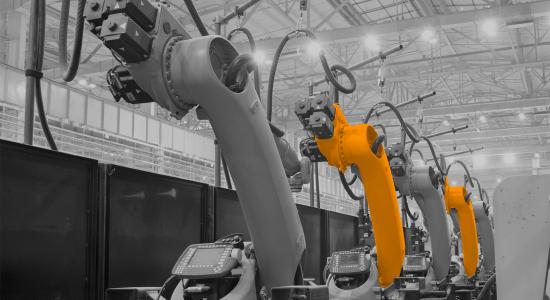“German industry is weakening!” read the headline in the Frankfurter Allgemeine Zeitung at the start of the Hanover Trade Fair 2019. Manufacturing companies must improve their production processes further if they want to stay competitive on a hard-fought market. One key technology for such improvement is the interconnectivity of things – but one that will not be able to develop its benefits to the full until 5G arrives. Companies will be required to build up new, complex 5G campus networks – in collaboration with telecommunications providers as well.
According to the ifo Institute, order entries in the manufacturing industry are on the decline. Faced with this situation, companies are making greater use of new technologies for the further optimization of their processes and for the development of new business models. According to a recent survey conducted by the VDMA, digitalization is at the top of the innovation list. The share of companies that have defined a digitalization strategy rose to 40% in 2018 and has doubled in only two years.
Challenge batch size 1
Three-fourths of the companies operating in machine construction rate internet of things (IoT) platforms as major factors for their further development. They expect the interconnection of machines as well as of production and logistic processes to lead to improved product quality, fewer incidents of production disruptions, and optimized utilization of factory capacities. Even if nothing else, fluctuations in order entry and the ups and downs of economic cycles can be more effectively managed through agile and flexible procedures. Moreover, even producers of mass goods are confronted with the challenge of turning themselves into custom producers of batch size 1.
We need the 5G network – this was one of the demands of manufacturing companies expressed at the Hanover Trade Fair, and two-thirds of the companies are planning to implement 5G by 2020, according to a non-representative panel from Gartner from 2018. They regard 5G to be an essential key to the realization of Industry 4.0 concepts that will pave the road to the smart factory. Neither driverless transport systems nor mobile tools and robots nor the interaction of humans and machines via augmented and virtual reality applications can be realized without high-performance wireless technology. “If we do not have a 5G network, we will not be able to realize this vision of the Industry 4.0 factory of the future. It is the nervous system. We need it,” said Boschrexroth executive officer Marc Wucherer at the opening of the Hanover Trade Fair 2019.
No other network offers comparable efficiency, guarantees, and the necessary low latency periods.
Billions in additional added value through 5G
We see that the expectations linked to 5G are euphoric, as are the forecasts of economic development with 5G. A figure of $2.2 trillion worldwide is predicted over the next 15 years when the new wireless standard becomes available (https://www.onvista.de/news/neue-gsma-studie-5g-wird-bis-2025-15-der-globalen-mobilfunkbranche-ausmachen-da-immer-mehr-5g-netzwerke-in-betrieb-genommen-werden-194774557). In Germany alone, digitalization in 2025 could mean additional added value of around €85 billion – although achieving this figure would require a fast and full-coverage 5G rollout. Until 5G has achieved full-area coverage through the rollout of 5G technology by the large telecommunications providers, however, several years will go by.
However, companies do not want to wait this long. They are planning to set up so-called campus networks by purchasing their own wireless frequencies. The regulatory authority in Germany has reserved frequencies in the range from 3.7 to 3.8 GHz and at 26 GHz for the establishment of these local 5G networks and intends to award them without an auction to companies, regional network operators, or municipalities. But frequencies alone do not make a campus network. According to a non-representative online survey conducted by Tech Pro Research, the majority of companies have indicated that 5G implementation will not be easy because, among other reasons, the existing infrastructure is not ready for 5G.
Lack of 5G know-how in the industry
Generally speaking, manufacturing companies lack the know-how for the construction and operation of the networks. They must set up a complex and complete infrastructure in a technological environment that is new to them. The structure of the network is just one of the special requirements that must be considered. Campus networks must cover all sections of the premises, so the 5G NR network coverage plays an essential role. Before the network architecture is put into place, 5G NR network measurements must clarify how closely spaced the transmission stations must be set up so that the advantages of 5G can be fully exploited. These network measurements must be repeatedly carried out during the installation so that disruptions between various sites, cells, and beams can be determined and remedied.
Midsize companies in particular that do not have any network competence should implement 5G campus networks in collaboration with a telecommunications provider or, as a minimum, with a system or consulting company that focuses on telecommunications. The installation of such complex company networks on the basis of a completely new technology confronts even telecommunications providers with new challenges. As a rule, they lack the know-how concerning what production and logistics processes the industry wants to improve. And at this time, they still lack the “end-to-end” understanding of concrete use cases.
Sustainable architecture for a 5G campus network
The challenges begin right away in the regulatory environment. Anyone who wants to set up a 5G campus network must first apply for frequencies from the regulatory authority. The architecture of the campus network should have a sustainable construction so that applications introduced at a later time can be integrated and operated without having to rebuild the architecture. Comprehensive data and IT security requirements are no small matter for the network; real-time applications in particular must be protected from attacks, and the companies must prevent access to important production data by white-collar criminals.
In addition, the integration of the applications based on 5G with existing systems such as ERP or MES systems is necessary so that data can be merged and analyses can be carried out on a broad scale. Last, but not least, the later operation of the 5G network cannot be compared with previous network structures. Essentially, 5G technology is a software-controlled network that must be managed actively. A 5G campus network can be tailored to a company’s requirements for specific local coverage and performance specifications. This includes as well the integration of an edge cloud that will shorten further the evaluation times of data, which is a prerequisite for making completely new services possible.
Cross-industry 5G partnerships
Owing to the complexity, it makes good sense (as is the case in other areas of digital transformation as well) to compile expertise from various sources in the form of cross-industry partnerships. Telecommunications providers and application companies can fully exploit the advantages of 5G capabilities through trials, test beds, and innovation partnerships. Representatives of the OT industry (operational technology), the ICT industry (information and communications technology) and academics have founded the 5G Alliance for Connected Industries and Automation (5G-ACIA) with this in mind and for the purpose of driving forward close collaboration among all relevant players.
The concrete form such partnerships can take is demonstrated by a campus network that Deutsche Telekom has begun operating in cooperation with OSRAM and that combines a public and a private network into one infrastructure. The campus network will cover the OSRAM works in Schwabmünchen and connect 3,000 things and products with one another. An edge cloud is also in use at OSRAM and processes the data in proximity to the application. Telekom plans to build a similar campus network for the automotive supplier ZF Friedrichshafen.
Since the beginning of 2018, the Hamburg Port Authority (HPA), operator of the Hamburg port, Deutsche Telekom, and Nokia have been testing 5G applications under live conditions in Hamburg’s port. Sensors on ships provide movement and environmental data in real time from large areas of the port. HPA controls the traffic flows in Hamburg’s port remotely. An augmented reality application shows 3-D data of the port premises in which planned structures are modeled in the current port image. Capacities of the network can be managed by means of network slices, making possible the disruption-free, parallel use of applications.
Further information on 5G in Deutsche Telekom's topic special
Fully networked factories on 5G basis
The automotive industry in particular expects great benefits from 5G because it sees its future in fully networked factories. Audi, for instance, is working with the supplier Ericsson to test industrial applications based on 5G and is planning to apply for an industry license and establish a 5G network within the plant. “A powerful network architecture that can respond in real time is of decisive importance for us. As part of the project with our partner Ericsson, we are running trials to determine what opportunities 5G technology offers for industrial use cases in the smart factory,” said Frank Loydl, chief information officer of AUDI AG, at the beginning of August 2018.
From a strictly technical perspective, the decisive advantages of the 5G standards are its high reliability, extremely short latency periods of less than one millisecond, and massive IoT connectivity. Hundreds of thousands of devices can simultaneously transmit and receive data even within a small area. Moreover, the security in comparison with Wi-Fi networks is significantly higher, making espionage and external disruptions more difficult by several orders of magnitude. Another great advantage of 5G is a uniform standard that supports sensor networks of stationary and mobile objects with the same wireless standard. Until now, the industry has complained about the heterogeneity of the standards as a serious drawback to existing technologies. In contrast, 5G creates a uniform network for the intelligent factory that connects machines from various manufacturers at the sensor and actuator level via a central monitoring and control unit.
Uniform standard for campus and public network
Conventional cable-connected technologies such as fieldbus and Ethernet as well as wireless technologies such as Bluetooth or Wi-Fi fall far behind in comparison with the process monitoring opportunities of 5G. The heterogeneity of the various networks will quickly diminish because the 5G wireless network is an excellent choice for applications from the shop floor to the office and can also be combined with other networks.
Thanks to the uniform standard, it will also be simpler in the future to connect in-house 5G networks with the public network because the public 5G network will be built on the same physical infrastructure as the campus or local network. This simplifies the connection of a number of local 5G networks via the public 5G network. If, for instance, you want to access machines at separate production facilities via a central control center, this can be realized as if in a consistently harmonized network and with low latency values similar to those of a closed campus network. This plays right into the hands of tooling machine manufacturers and others who offer predictive maintenance services and business models. Consistent networking throughout production will significantly accelerate digital transformation in this area. Conventional, static production lines that produce the same products over periods of weeks or months will be a thing of the past once 5G is here.
Guaranteed latency periods thanks to edge and network slicing
The interaction of sensors, machines, and humans will be supported by so-called network slicing that enables quality of services. Dedicated resources can be allocated to specific applications. Fixed transmission rates and latency periods can be set for applications critical for production. This is an enormous advantage over Wi-Fi networks in which all transmitting and receiving devices share the bandwidth equally.
Moreover, the data will not travel first from the end device via the base station and optical fiber to the cloud in the internet, but only just downstream from the base station where the processing intelligence should be placed. This is the trick behind the short latency periods. Normally, the data must travel the route from device to network to cloud. This has an impact on AR/VR applications in particular that make high demands on computing power. The goal is to shift the processing of the data closer to the device, thus reducing latency periods. An added benefit is that the data, many of which are critical, remain in the campus environment and consequently in a secure area.








